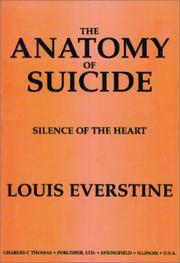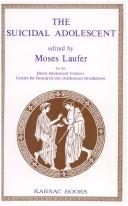| Listing 1 - 10 of 103 | << page >> |
Sort by
|
Book
ISBN: 1536170003 Year: 2020 Publisher: New York : Nova Science Publishers,
Abstract | Keywords | Export | Availability | Bookmark
 Loading...
Loading...Choose an application
- Reference Manager
- EndNote
- RefWorks (Direct export to RefWorks)
"Everyone who dies by suicide has thought about suicide prior to their action. Suicidal ideation is, therefore, one of the most important risk factors for suicide. This book explores and illustrates current research on this risk factor. There are reviews of selected aspects of suicidal ideation. Karolina Krysinska and David Lester review research on whether religiosity is a protective factor for suicidal ideation, while John Gunn reviews whether bullying is a risk factor. Cathy Pederson reviews research on suicidal ideation in the chronically ill. Three research studies are presented: Mahboubeh Dadfar on mattering as a protective factor in Iranian psychiatric patients, Jenny Huen and her colleagues on correlations of suicidal ideation in Chinese students, and Steven Stack on suicidal ideation in men who have been raped. The content of suicidal ideation is discussed by James Overholser and his colleagues, and Jennifer Laffier presents examples of suicidal communications in social media. Finally, Frank Bailey presents two case studies of individuals in which their suicidal ideation is presented in the context of their life histories. The chapters illustrate the importance and the complexity of suicidal ideation and its role in leading to suicidal actions"--

ISBN: 0398082626 0398068038 Year: 1998 Publisher: Springfield : Charles C Thomas,
Abstract | Keywords | Export | Availability | Bookmark
 Loading...
Loading...Choose an application
- Reference Manager
- EndNote
- RefWorks (Direct export to RefWorks)
Statistically, suicide ranks eighth among all causes of death in America. The basic premise of this book is that there is one and only one cause for willful suicide. When that cause is absent, suicide will not occur. Thwarting a suicide plan involves teaching the person what life means. The author explores the scope of this problem which involves clinical and ethical issues; the myth of depression; the path to suicide; unfinished business; staying alive; early warnings; first interventions; the self-contract; cases in point and the future of suicide. Written for psychologists, counselors, and
Book
Year: 2004 Publisher: Montréal : Presses de l'Université de Montréal,
Abstract | Keywords | Export | Availability | Bookmark
 Loading...
Loading...Choose an application
- Reference Manager
- EndNote
- RefWorks (Direct export to RefWorks)
Pourquoi décide-t-on de mettre un terme à sa vie? Tente de comprendre le suicide pour mieux le prévenir. Analyse différents aspects : les facteurs de risque, les différences entre pays, les différences entre suicide et euthanasie ... Les auteurs préconisent une vraie concertation entre familles, chercheurs et intervenants pour aborder ces questions.
Suicidal behavior. --- Suicide --- Prevention.
Book
ISBN: 1536164690 Year: 2019 Publisher: New York : Nova Science Publishers,
Abstract | Keywords | Export | Availability | Bookmark
 Loading...
Loading...Choose an application
- Reference Manager
- EndNote
- RefWorks (Direct export to RefWorks)
"In this compilation, the authors provide a literature review of the relationship between hormones including testosterone, prolactin, leptin, hypothalamus-pituitary-adrenal axis hormones, hypothalamus-pituitary-thyroid axis hormones, oxytocin, ghrelin, estradiol and progesterone, insulin, melatonin and suicidal behavior, which has potential public health and clinical significance. Next, protective factors for suicide are highlighted. The discussion also shows how these protective factors also interact with risk factors to provide a buffering effect, thus preventing suicide. A further discussion on prevention in at-risk groups is also conducted. To assess which protective variables are more predictive of a greater or lesser lethality of a previous suicide attempt, the authors study the concept of implementing a higher level of resilience to possible retries at 6 and 12 months after the first attempt. The sample was comprised of 166 people who had been admitted to the emergency services due to a suicide attempt. The purpose of the concluding study is to test whether a distal environmental factor, childhood maltreatment (including physical, sexual and emotional abuse), and more proximate cognitive and affective factors are shared correlates of suicide attempts and dating violence perpetration"--
Suicidal behavior. --- Suicide --- Prevention.

ISBN: 042992237X 0429908148 0429483376 1282900420 9786612900426 1849401918 9781849401913 1855751216 9781855751217 Year: 1995 Publisher: London : Karnac Books,
Abstract | Keywords | Export | Availability | Bookmark
 Loading...
Loading...Choose an application
- Reference Manager
- EndNote
- RefWorks (Direct export to RefWorks)
Contains a wealth of case material illuminating many aspects of a harrowing problem. The book provides practical therapeutic insights, and also a model of why adolescents might become suicidal.
Book
ISBN: 1317757874 1315798883 1317757882 9781317757887 Year: 2014 Publisher: New York Routledge
Abstract | Keywords | Export | Availability | Bookmark
 Loading...
Loading...Choose an application
- Reference Manager
- EndNote
- RefWorks (Direct export to RefWorks)
First published in 1987. Routledge is an imprint of Taylor & Francis, an informa company.
Book
ISBN: 0398080909 Year: 2014 Publisher: Springfield : Charles C Thomas,
Abstract | Keywords | Export | Availability | Bookmark
 Loading...
Loading...Choose an application
- Reference Manager
- EndNote
- RefWorks (Direct export to RefWorks)
Some researchers in the field of suicidology think that the old theories of suicide are too constraining and impede advances in the understanding of suicide. However the book's authors are not quite so critical of past theories. In the book they review the classic theories of suicide, both psychological and sociological, because they are the foundation of our current theories and also propose the skeletons of possible future theories. The goal of the text is to present researchers with theories to guide their research, encourage them to modify these theories, perhaps meld them together in some
Book
ISBN: 1283907259 0857002244 9780857002242 9781849051156 1849051151 9781283907255 Year: 2011 Publisher: London Philadelphia Jessica Kingsley Publishers
Abstract | Keywords | Export | Availability | Bookmark
 Loading...
Loading...Choose an application
- Reference Manager
- EndNote
- RefWorks (Direct export to RefWorks)
Working with Suicidal Individuals provides a comprehensive guide to understanding suicide, the assessment of risk, and the treatment and management of suicidal individuals. It covers the theory behind suicidal behaviour, using Transactional Analysis to explore the personality types of suicidal individuals and to understand their motivations.
Suicidal behavior. --- Suicidal behavior --- Suicide --- Treatment. --- Risk factors.
Book
ISBN: 1536117994 9781536117998 9781536117882 1536117889 Year: 2017 Publisher: New York
Abstract | Keywords | Export | Availability | Bookmark
 Loading...
Loading...Choose an application
- Reference Manager
- EndNote
- RefWorks (Direct export to RefWorks)
Teenagers --- Teen suicide --- Teenage suicide --- Suicidal behavior.
Book
ISBN: 1616685409 9781616685409 1608762017 9781608762019 Year: 2009 Publisher: New York
Abstract | Keywords | Export | Availability | Bookmark
 Loading...
Loading...Choose an application
- Reference Manager
- EndNote
- RefWorks (Direct export to RefWorks)
Soldiers --- Peacekeeping forces --- Suicide --- Suicidal behavior. --- Prevention.
| Listing 1 - 10 of 103 | << page >> |
Sort by
|

 Search
Search Feedback
Feedback About UniCat
About UniCat  Help
Help News
News